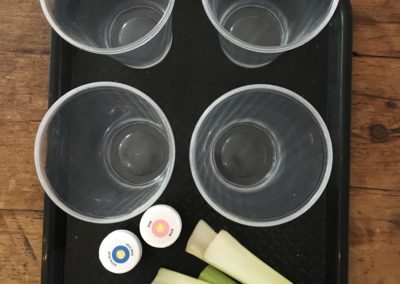Where Did All the Water Go?
Developed by Rachel Greenberg, PCM Play Intensive 2021
(FOCUS: K-2; Language & Literacy, Science, Technology, Engineering and Mathematics (STEM))
As plant researchers, we have grappled with how to water our plants when we are away for the weekend or vacations. We figured it out! Now, we need to figure out where the water goes after we put it in the soil. Everything that is absorbed into the soil affects what we harvest from the earth. Plants help us to survive in many ways. How can we help them?
Materials
- Celery stalks (at least two per student)
- Carnations (if available for extension)
- Clear plastic cups
- Pitchers or bottles of water
- Food coloring
- Recording sheets for observations
- Tray to keep cups on
- Masking tape (for labeling cups)
- Chart paper to record ideas
Set Up
Each table should have four stalks of celery, two water bottles or pitchers, four plastic cups and two bottles of food coloring (random colors). Leave blank masking tape pieces (one for each cup) on the table. The tray for the cups should be set up in a central location.
Student’s Job
Where does the water go after we water the plant? How can we show the water’s path?
Day One: Today, we will start observing what happens to water as it travels through plants. We will set up our research stations and throughout the week we will check on them to observe and record progress.
First, you will pour some water into your cups. Next, you will put five drops of food coloring into each cup. Then, you will place your celery stalk in the colorful water. After this initial set up, we will record our observations by using words and pictures to show what we see.
Observations could be made in a myriad of ways including with paper, pencils and crayons; colorful construction paper, scissors, and glue; shoeboxes with pipe cleaners, etc.
After creating our first observations, we will talk with our partner about what we think will happen to our celery and chart our predictions on chart paper.
Day Two: Observe, record, and discuss observations with partner. Chart idea changes on chart paper.
Day Three: Final observe, record, and discuss observations with partner. Finish collecting ideas on chart paper chart.
Further Challenges:
We know what happens when we put celery in colorful water. What do you think will happen if we put a flower into our colorful water? How do you think this connects to the leaves changing color in the fall? What do you think happens if polluted water drops on the ground? How could we prevent it from traveling up through the plant?
Extension activity ideas:
- Create a working model of capillary action! Use materials you have in the classroom, such as makerspace materials, straws, etc.
- Collect rainwater outside the classroom and see how wet and dry environments change when rainwater is applied.
- How much is too much pollution? Use food coloring to symbolize different types of pollution (e.g., oil, salt, fertilizer, pool water, cleaner, etc.) and explore the effects on plants and flowers.
Teacher’s Job
Standards Alignment
COMMON CORE STATE STANDARDS.MATH.PRACTICE.MP1
Make sense of problems and persevere in solving them.
COMMON CORE STATE STANDARDS.MATH.PRACTICE.MP3
Construct viable arguments and critique the reasoning of others.
COMMON CORE STATE STANDARDS.ELA-LITERACY.SPEAKING & LISTENING.1.1
Participate in collaborative conversations with diverse partners about Grade One topics and texts with peers and adults in small and larger groups.
COMMON CORE STATE STANDARDS.ELA-LITERACY.SPEAKING & LISTENING.1.5
Add drawings or other visual displays to descriptions when appropriate to clarify ideas, thoughts, and feelings.
NEXT GENERATION SCIENCE STANDARDS: ENGINEERING, TECHNOLOGY, AND APPLICATIONS OF SCIENCE
K-2-ETS1-1. Ask questions, make observations, and gather information about a situation people want to change to define a simple problem that can be solved through the development of a new or improved object or tool.
K-2-ETS1-2. Develop a simple sketch, drawing, or physical model to illustrate how the shape of an object helps it function as needed to solve a given problem.
Connections to previous work?
First graders are studying plant structures and how human interaction affects plants. This curriculum is provided through ARC Unit 4. This is a continuation of the first lesson where students created contraptions to water their plants over weekends and vacations. Watching water flow through plants takes their knowledge of plant structure deeper and connects STEM to literacy in a concrete way.
Prepare/ Background Info
Students have read What Do Roots Do? and Seed Go, Seeds Grow to understand why water is important to plants and that roots “drink” the water underground. This lesson answers the question “Where does the water go?”
Facilitation Strategies
Walk around and ask questions to prompt exploration and communication, such as:
- What makes you think that?
- What’s your evidence?
- What does your partner think?
- Check out ____’s observation. That might help you.
Play to Notice
Notice that water moves through the celery/carnation in one direction. Notice that using other people’s ideas for observation can make your observation better.
Content Matter to Notice
Plant roots are where the water enters the plant, and plant leaves are where the water leaves the plant.
SEL to Notice
Observe how using accountable talk stems to talking to each other during creation and observation time and how sharing ideas freely and being open to using someone’s feedback makes your work better.



0 Comments